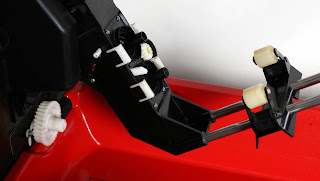Jobo FAQ
This FAQ page will discuss the various options in choosing a manual Jobo processor.For more information about AutoLab options, please contact us directly.
CatLABS always recommends working with a lift, so this page assumes that all processors discussed are equipped with a lift.
How to Choose the Right Processor
Jobo processors are divided into two main categories: fully automatic processors and manual processors.
Automatic processors are usually called AutoLabs, and are available in two sizes: compact, tabletop processors and large, commercial-style processors.
Except for the ATL1000, all other AutoLabs are fully user-programmable and have various levels of automation. However, they all (ATL1000 included) share the three main automatic features that make them fully automatic: automatic agitation, automatic temp control and automatic timed fill/drain of chemistry to the processing tank and rinse.
Manual processors are divided into two groups that are defined by size and capacity: large processors (CPA2, CPP2, and the all-new CPP3) and small processors (CPE2 and CPE2+)
All AutoLabs and manual processors share the same main features: automatic agitation and automatic temp control.
The maximum motor load capacity suggested by Jobo for the small machines is 600ml, whereas the large machines can handle up to 1,500ml.
Expert drums cannot be used on CPE2/CPE2+ machines.
The CPE2 system houses 600ml bottles. Any run for which a larger amount of chemistry is needed requires auxiliary chemical storage bottles. Jobo 1000ml bottles fit perfectly into the CPE2 slots.
Maximum Format Sizes
CPE2/CPE2+:
- Up to 2 sheets of 8X10 in a 2830
- Prints up to 12X16 in a 2840
- Up to 12 sheets of 4X5 in a MultiTank 6 with 2X 2509 reels
- Up to 6 rolls of 35mm, 8 rolls of 120 or 4 rolls of 220
Note that running 8 rolls of 120 requires 800ml and will exceed the safe maximum motor load capacity.
Up to 10 rolls of 120, or 8 rolls of 35mm can be loaded in a 1500 system tank (1520+1530+1530), but this will also exceed the safe maximum motor load capacity of the system.
Expert drums (3000 system) cannot be used on any CPE2 system.
-
CPA/CPP:
- ULF or prints up to 20X24 in a 3063 expert drum
- Up to 18 sheets of 4X5 in a MultiTank 8 with 3X 2509 reels
- Up to 12 rolls of 35mm in a Multitank 12, 16 rolls of 120 or 8 rolls of 220
Note that these max roll capacities exceed the safe max motor load capacity.
Similar max roll film capacities can be run in 1500-system tanks as well.
All expert drums can be run on CPA or CPP machines.
Temperature Control
Both the CPE2 and CPA2 systems use a mechanical dial thermostat control system to set and regulate the processing temperature.
Though the dial itself is not very precise, the thermostat is accurate up to 0.1C.
The system is designed to be used with a trusted thermometer, such as the Jobo #3321 process thermometer, which has specially designed holding brackets in both systems.
The temp is set against the thermometer reading, and the dial is adjusted as needed.
Once the desired temperature is attained, the machine will hold it within 0.1C.
The CPP2 and CPP3 use an electronically-controlled thermostat system to regulate temperature after it is set by the user, and it displays the temperature on an LCD panel.
This system is also accurate to 0.1C. Because the readout displays the actual temperature, there is no need for an auxiliary thermometer.
The CPP2 and CPP3 employ a cold-water inlet solenoid, which can cool down the main water trough when hooked up to a water supply (in case of overheating).
So How Do I Know Which One To Choose?
Choosing by film size/format:
If you shoot primarily sheet film (4X5, 5X7, 8X10), you will want to use expert drums.
Expert drums are considered some of the best sheet film processing solutions ever designed and are an industry standard. They offer unsurpassed results in comparison to most other available processing methods.
Expert drums can only be used on CPA and CPP systems with a lift, so that decision can be an easy one.
The CPA/CPP system will also be ideal for all users who want to have the ability to run large batches of roll film at once.
If you want to process any prints or ULF that are larger then 12X16, you will have to use a CPA/CPP system.
The 2850 tank offers print/ULF size capacity of up to 16X 20, and the 3063 expert drum offers print/ULF size capacity of up to 20X24.
All Jobo systems allow for a minimum run of 1 roll, with no waste of chemicals. If you are planning on using Expert drums on a CPA/CPP system, you will also be able to run small batches of roll films.
If you are a small-time user, usually running small batches of film (1–4 rolls or 1–6 sheets of 4X5), the CPE2 can be ideal.
Choosing by processor size:
CPA/CPP systems have a footprint of about 16X40 inches. With the lift attached, the total height of the machine is about 24 inches. The water trough needs about 19 liters of water.
CPE2 systems have a footprint of 15X28 inches. With the lift attached, the total height of the machine is 23 inches.
Why Do I Need A Lift?
CatLABS recommends using a lift for all processors and processing systems, because it:
- Helps create a more accurate and repeatable process
- Allows chemistry to be introduced into the tank while the agitator is on
- Allows for more accurate processing times down to the second, as well as faster introduction and dumping of chemistry
- Alleviates pressure build-up problems in problem-prone process types
- Creates a nearly dry and clean work environment
- Self-cleaning/helps prevent cross contamination
Regular Lift vs. New-Style Lift
The "new-style" lift has several advantages over the "regular" lift:
- More durable tank retaining clips
- Easier loading/unloading of tanks, thanks to improved tank retaining clips design
- Automatic upper/lower funnel selector
- Internal brass fittings
- Longer-lasting drain hose
New-Style Lift:

Regular-Style Lift:

Why Are JOBO Serial Numbers Important?
The original CPA/CPP design dates back to the early ’80s. Over the years, Jobo introduced new, larger tanks to its lineup, eventually replacing the old, non-modular drums with the all-modular 1500 and 2500/2800 system tanks. As capacities grew, so did the tanks.
Large-capacity tanks were offered for high-volume users in commercial operations, who were equipped with the larger ATL machines. Those machines were designed to handle larger loads, with stronger motors and supporting electronics.
To enable CPA/CPP users to use the larger-capacity drums and then the expert drums, the design underwent several minor adjustments over the years. A detailed description of the changes can be found in the Jobo publication below.
The final and most major changes that influence the longevity and reliability of the CPA/CPP system were made in the last production model design, which specifies an all-new motor and a power circuit-board design installed in all machines starting with SN 22001.
A new rotation motor, the same as used in the large commercial ATL machines, coupled with a more powerful DC support board, increased the capacity of the CPA/CPP system to that of the larger ATL machines, thus keeping the expert drum’s extra load well within the maximum load limit of the motor. The same motor and similar design are still used today in the CPP3.
The new motor features a new-style conical drive shaft, with a screw tap to lock in the main drive cog. This is an improvement over the old collet clamp design and it makes all late production model machines easily recognizable, because they have a hex screw holding on the cog instead of the flathead screw used in all other machines.
Rotation Motor Upgrades for the CPP-2 and the CPA-2 Processors
Introduction
Newer systems, like the 3000 series EXPERT Drums, require increased strength in the rotation motor circuit. This extra load can make the rotation speed of the tank or drum sluggish. The 3000 series EXPERT Drums create the heaviest possible load for the rotation motor circuit.
Beginning production of the CPP and CPA had a single-bearing rotation motor.
CPP Serial # ARXXXX-10593
CPA Serial # ARXXXX-10312
1st Upgrade: The single-bearing rotation motor was replaced by a double-bearing rotation motor.
CPP Serial # 10594-20455
CPA Serial # 10313-13309
2nd Upgrade: The rotation motor circuit was strengthened to accommodate larger loads, that is, 3000 series EXPERT Drums.
CPP Serial # 20456-21999
CPA Serial # 13310-21999
3rd Upgrade: A stronger rotation motor (the same as in the ATLs) was introduced and the rotation-motor circuit was strengthened to accommodate the new motor.
CPP Serial # 22000-present
CPA Serial # 22000-present
